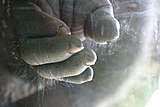Nails (anatomy)
| Nail | |
|---|---|
 |
|

A gorilla's fingernails
|
|
| Details | |
| Identifiers | |
| Latin | unguis |
| Code | TH H3.12.00.3←→≥≥.02001 |
| TA | A16.0.01.001 |
| FMA | 54326 |
|
Anatomical terminology
[]
|
|
A nail is a horn-like envelope covering the tips of the fingers and toes in most primates and a few other mammals. Nails are similar to claws in other animals. Fingernails and toenails are made of a tough protective protein called keratin. This protein is also found in the hooves and horns of different animals.
The nail consists of the nail plate, the nail matrix and the nail bed below it, and the grooves surrounding it.
The matrix, sometimes called the matrix unguis, keratogenous membrane, nail matrix, or onychostroma, is the tissue (or germinal matrix) which the nail protects. It is the part of the nail bed that is beneath the nail and contains nerves, lymph and blood vessels. The matrix is responsible for producing cells that become the nail plate. The width and thickness of the nail plate is determined by the size, length, and thickness of the matrix, while the shape of the fingertip itself shows if the nail plate is flat, arched, or hooked. The matrix will continue to grow as long as it receives nutrition and remains in a healthy condition. As new nail plate cells are made, they push older nail plate cells forward; and in this way older cells become compressed, flat, and translucent. This makes the capillaries in the nail bed below visible, resulting in a pink color.
The lunula ("small moon") is the visible part of the matrix, the whitish crescent-shaped base of the visible nail. The lunula can best be seen in the thumb and may not be visible in the little finger.
The nail bed is the skin beneath the nail plate. Like all skin, it is made of two types of tissues: the deeper dermis, the living tissue which includes capillaries and glands, and the epidermis, the layer just beneath the nail plate, which moves toward the finger tip with the plate. The epidermis is attached to the dermis by tiny longitudinal "grooves" called matrix crests (cristae matricis unguis). In old age, the nail plate becomes thinner, and these grooves become more visible.
...
Wikipedia
